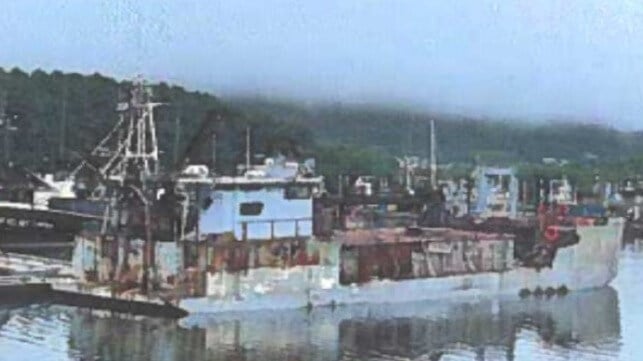NTSB: Aging Vessel Lost Due to Lack of Fundamental Watertight Integrity

The National Transportation Safety Board is pointing out some of the fundamentals of vessel operations along with the dangers of aging vessels in its latest report. The report shows that an 80-year-old Navy surplus vessel being used to support Alaska’s fishing industry was lost due to flooding possibly caused by maintenance issues and the captain and mate’s decision to leave watertight doors open while they were underway.
The vessel named Cape Douglas was lost on November 6, 2024, about four miles southeast of Kodiak, Alaska. The captain and mate reported they were unable to control flooding on the vessel and abandoned ship to a towed skiff. They flagged down a nearby fishing boat for their rescue. Less than an hour after the captain and mate donned survival suits and abandoned ship, 40 minutes after they were rescued, they watched the industrial ship they had been operating sink.
The NTSB reports the Cape Douglas was built for the U.S. Navy in 1944 as a landing craft tank. By 1947, it had been decommissioned and found its way to Alaska where it was sailing from Kodiak as a commercial fishing vessel. It was acquired by North Bay Corporation in 2000 and used to haul heavy equipment and as a fish tender to dispose of fish byproducts.
It was on one of those fish tender runs loaded with about 30 tons of fish byproduct which the captain termed a “moderate load.” The disposal site was about four miles southeast of Kodiak in Chiniak Bay, and they were making about 5.5 knots. The captain was trying to start a pump used for offloading when he observed water had flooded into the engine room. The mate estimated there were four feet of water in the engine room but a high-water bilge alarm had not sounded. The captain later told the NTSB that he did not know when it had been last tested or if it was functional.
The captain told the NTSB investigators he was unable to enter the engine room. He said the water, “seems to be coming in awfully quick.” He confirmed they regularly left the watertight doors open during transit to “help with ventilation in the engine room.”
The NTSB reports the vessel had last been surveyed in August 2022 and the report found wastage greater than 15 percent and many sections exceeding 25 percent as well as rust and other issues. The owner was told the vessel was only suitable for local limited fish waste dumping and would require an extensive refit for any heavy load/freight operations. The vessel was not used between the survey in 2022 and the trip in November 2024. The owner was trying to sell the vessel.
The City of Kodiak harbormaster also raised concerns in April 2024 over the vessel’s seaworthiness. The harbormaster cited “significant marine growth” and “indications of disrepair.” NTSB says the operating company resolved the complaint by providing proof of vessel insurance.
The report lists the probable cause as flooding from an undetermined failure in the vessel’s deck washdown system. It also points to the fundamental principle of maintaining watertight integrity saying leaving the watertight doors open likely contributed to the casualty.
It is another example of aging vessels being used in the fishing industry. In 2023, the U.S. Coast Guard in Tacoma, Washington had to manage a situation with a 77-year-old fish processing vessel after there were reports of an ammonia leak. The ship had a long list of violations and after the leak was addressed, it was listed as a derelict for disposal.
